Swedish Saffron Buns “Lussekatter” (or St Lucia Buns) are an S-shape sweet bun flavored with saffron. They are traditionally eaten around Christmas in Sweden, and especially on Saint Lucy’s Day, together with some mulled wine “glögg”.
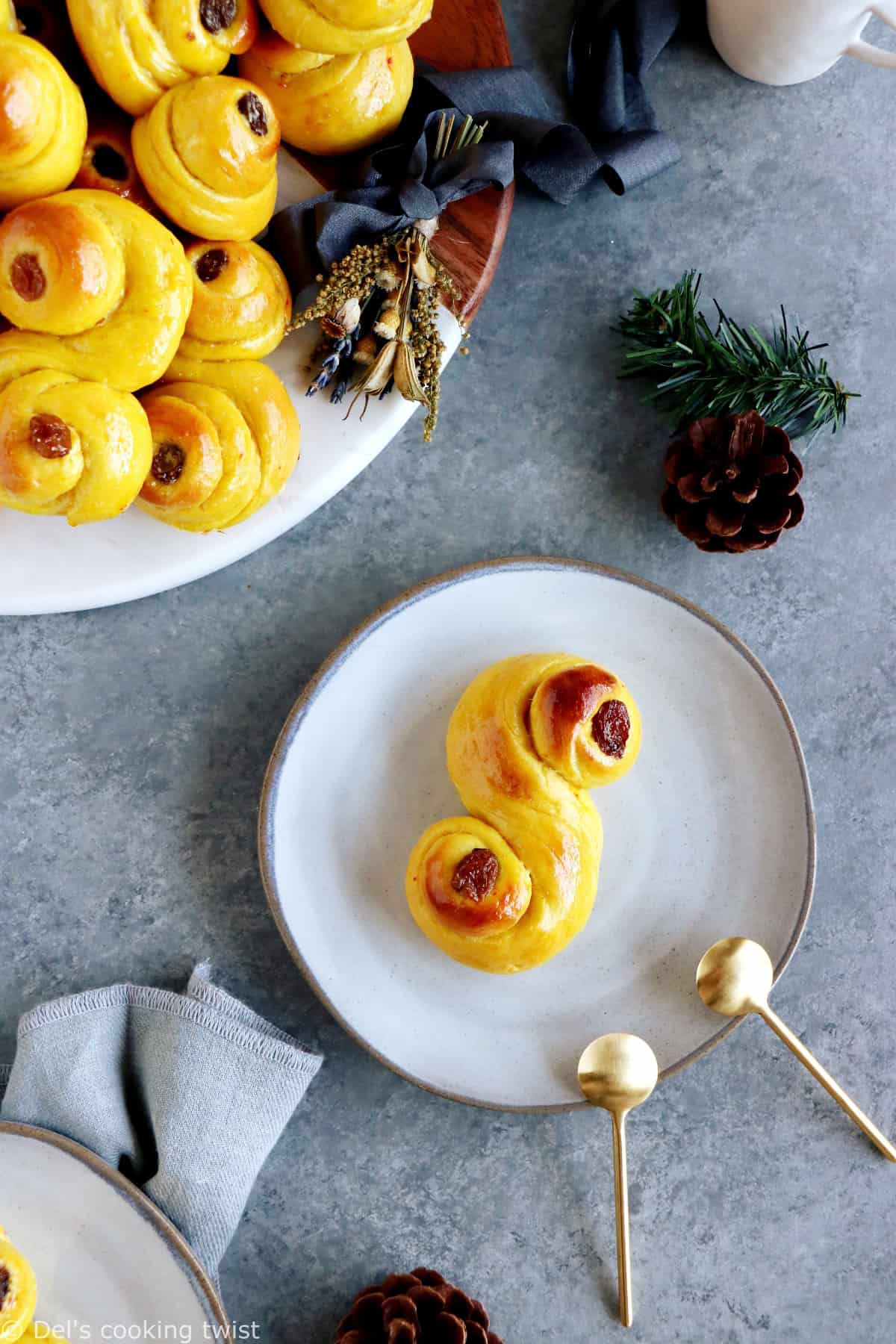
Email me this recipe
We’ll send it straight to your inbox, along with weekly food inspiration!
Santa Lucia: A lovely Swedish tradition
One of my favorite Swedish traditions is Luciadagen (literally “Lucia Day”), on December 13th. Most aspects of the festivities celebrate light and the event is one of the biggest celebrations during Advent in Sweden. It’s also the reason why we named our sweet baby Lucie, that brought light to our lives. And like for most Swedish celebrations, St Lucy’s Day comes with a dedicated traditional pastry: some delicious curled up saffron buns!
What is St Lucy’s Day? On Luciadagen, there are processions featuring choirs of children all dressed up in white robes with a red sash, singing together with one girl selected as “Lucia” who wears a crown of lit candles, while the others carry a single candle. Traditionally it is said that at home, the oldest girl would deliver coffee and saffron buns to her parents’ bedroom for breakfast.
Nowadays, St Lucy’s Day is a very festive day observed in the entire country of Sweden, with choirs of children singing everywhere, mostly in school or at church, but also visiting some hospitals or elderly home to bring light to everyone’s life. And the event is usually followed by the traditional fika with saffron buns served along with mulled wine glögg.
The origins. Like many winter celebrations, St Lucy’s Day blends Christian and pagan practices. Prior to the conversion to the Gregorian calendar, December 13th was the longest night of the year. While waiting for longer days, people would sing and light bonfires to drive away darkness and nefarious spirits. After Sweden’s conversion to Christianity around the 12th century, legends surrounding St. Lucia (a figure also associated with light) were incorporated into the tradition. Although we have no evidence that Lucy existed for real, she is nonetheless strongly connected to light.
What is a Swedish Saffron Bun Lussekatter?
The curled saffron buns that go with this traditional celebration are S-shaped, with a single raisin in the center of each spiral. They are lightly sweet, soft and fluffy, with a vibrant yellow from the saffron-infused dough.
Why is it called Lussekatter? It is thought that the buns were originally modeled after a sleeping cat (the S-shape being the curled up tail), believed to ward off the devil. Although cats were traditionally a figure associated with the devil, the use of saffron would bring some “magical” properties to the buns, altogether with a bright, sunny color. With this reasoning, the original name of “devil cat”(djävulskatter in Swedish) later changed to the more polite “Lucia cat” (lussekatter), strongly associated to light.
Ingredients and how to use them
I tried several saffron bun recipes over the years, with various results. With this recipe, I can guarantee a soft and fluffy texture, and lightly sweetened buns.
Except for the saffron of course, which is a pricey spice, you need very basic ingredients:
- All-purpose flour. The quantity of flour can vary a little depending on the brand you use and its density. Instead of sticking exactly to the measurements, try to “feel the dough”: it needs to be supple, slightly elastic, and slap from the sides of the bowl. Don’t add too much flour or your dough risks being a little too dry.
- Fresh yeast. Check the yeast ratio below if you need to convert it into dry yeast.
- Milk + melted butter. The way it works is the following: melt butter in a saucepan, then pour the milk over. The temperature should be lukewarm around 98°F (37°C). If too hot, it can kill the yeast, if too cold, the risk is that it won’t activate the yeast enough.
- Sugar. To sweeten the buns a little bit. Note that saffron buns are generally mild and not too sweet.
- Egg. It brings some moisture to the dough.
How to use saffron? This pricey red spice which tints food in a bright yellow color comes in various qualities. So first things first, make sure the one you’re using is of great quality, not too old, and stored in a sealed container/package. Now in order to develop its flavor, mix saffron with a little bit of sugar and some brandy of your choice and let sit for a little while before using (ideally overnight). Be aware that saffron stains easily so try to not spill it out on your countertop.
Perfect yeast ratio:
In order to convert from fresh yeast to active dry yeast, multiply the fresh quantity by 0.4. To convert from fresh yeast to instant dry yeast, multiply the fresh quantity by 0.33.
How to shape lussekatter?
The traditional so-called Lussekatter come in an S-shape, but it comes with many possible variations. It’s actually a very entertaining activity to do with kids (each year I find an excuse to “borrow” my friends’ kids as little “helpers” to shape the buns). Here’s how to do the traditional shape:
- Break off a piece of dough and form it into a ball, of about 60 to 70gr (you don’t have to be exact).
- Roll the ball out into a snake.
- Then curl the ends in opposite directions, forming an S-shape with spirals at each end.
- Brush with beaten egg and place raisins in the centers of the “S” spirals.
Leftovers and storage
Usually, we recommend to eat these buns the day of baking, as they tend to dry up easily over time. If however you happen to have leftovers (which you will, most certainly), here are 3 options you may consider:
- Freeze them right away in a ziploc bag, and keep them up to 3 months.
- Slice them in two, toast them, and spread butter on each side. It makes a perfect saffron morning toast for breakfast!
- Use them to make French toast brioche casserole.
Other recipes using saffron:
- Saffron Cheesecake
- Braided Saffron Bread with Vanilla Custard
- Moist Orange and Saffron Mini Cakes
- Saffron Pear Tarte Tatin
- Crepes with Saffron and Rum
More traditional Swedish pastries to discover:
- Classic Swedish Cinnamon Rolls (Kanelbullar)
- Swedish Orange Cardamom Buns
- Swedish Semlor
- Ooey-Gooey Swedish Chocolate Cake (Kladdkaka)
- Swedish Vanilla Hearts (Vaniljhjärtan)
Swedish Saffron Buns (Lussekatter)
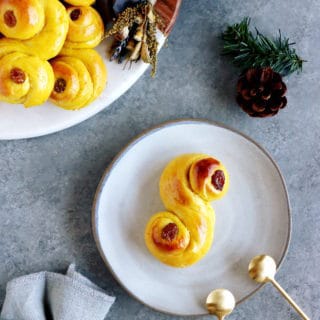
- Prep Time: 2 hours
- Cook Time: 7 mins
- Total Time: 2 hours 7 mins
- Yield: 36 buns 1x
- Category: Breads and Brioches
- Cuisine: Swedish recipes
Swedish Saffron Buns “Lussekatter” are an S-shape sweet bun flavored with saffron and containing a single raisin in each curl.
Email me this recipe
We’ll send it straight to your inbox, along with weekly food inspiration!
Ingredients
For the dough:
- 1g saffron
- 2 Tablespoons (30 ml) cognac or other brandy
- 2 Tablespoons (30g) sugar
- 1.7 ounces (50 g) fresh yeast
- 2 cups (50 cl) milk
- ¾ cup + 2 Tablespoons (180g) sugar
- ¾ cup (175g) unsalted butter
- 1 large egg, beaten
- 7 to 7 1/2 (840-900g) all-purpose flour
- 1/2 teaspoon salt
For brushing:
- 1 large egg, beaten
- 1 Tablespoon milk
For raisins:
- 1 handful raisins
Instructions
- The day before: place the raisins in a small bowl and pour strong alcohol (cognac for instance) over it. In another bowl, dissolve saffron in cognac mixed with 2 Tablespoons of sugar, and let macerate overnight.
- The D Day: crumble the yeast in a small bowl and dissolve with a little bit of milk and sugar. Let sit for 5 minutes.
- In a saucepan melt the butter and pour in the milk. Heat to 98°F (37°C) and remove from the heat.
- Transfer the yeast to a large bowl and pour in the milk-butter mixture, stirring as you go.
- Add the saffron mixture, sugar, egg, and the flour little by little, until you get a smooth but sticky dough.
- Knead the dough for about 15 minutes by hand or using a stand mixer with a paddle attachment.
- Cover the bowl with a tea towel and set aside for 60 minutes. Let it rise until doubled in size.
- Punch down the risen dough. Lightly knead two or three times on a floured surface.
- Pinch off small handfuls of dough (1.7 oz/50g each) and roll into long “snakes”. Shape snakes into “S”-shaped buns, and add two raisins in each bun. Carefully transfer the buns onto a baking tray lined with parchment paper.
- Preheat the oven to 420°F (220°C).
- Mix ingredients for brushing and brush onto the buns.
- Bake for about 7 minutes, just until slightly brown. Transfer to a wire rack and let cool completely.
Did you make this recipe?
Lastly, if you make this Swedish Saffron Buns (Lussekatter), be sure to leave a comment and give this recipe a rating, letting me know how you liked it. And of course, don’t forget to tag me on Instagram! Thank you and enjoy!
Important note: this blog post was updated as of December 4th, 2020 with new photos, more detailed instructions and much more.
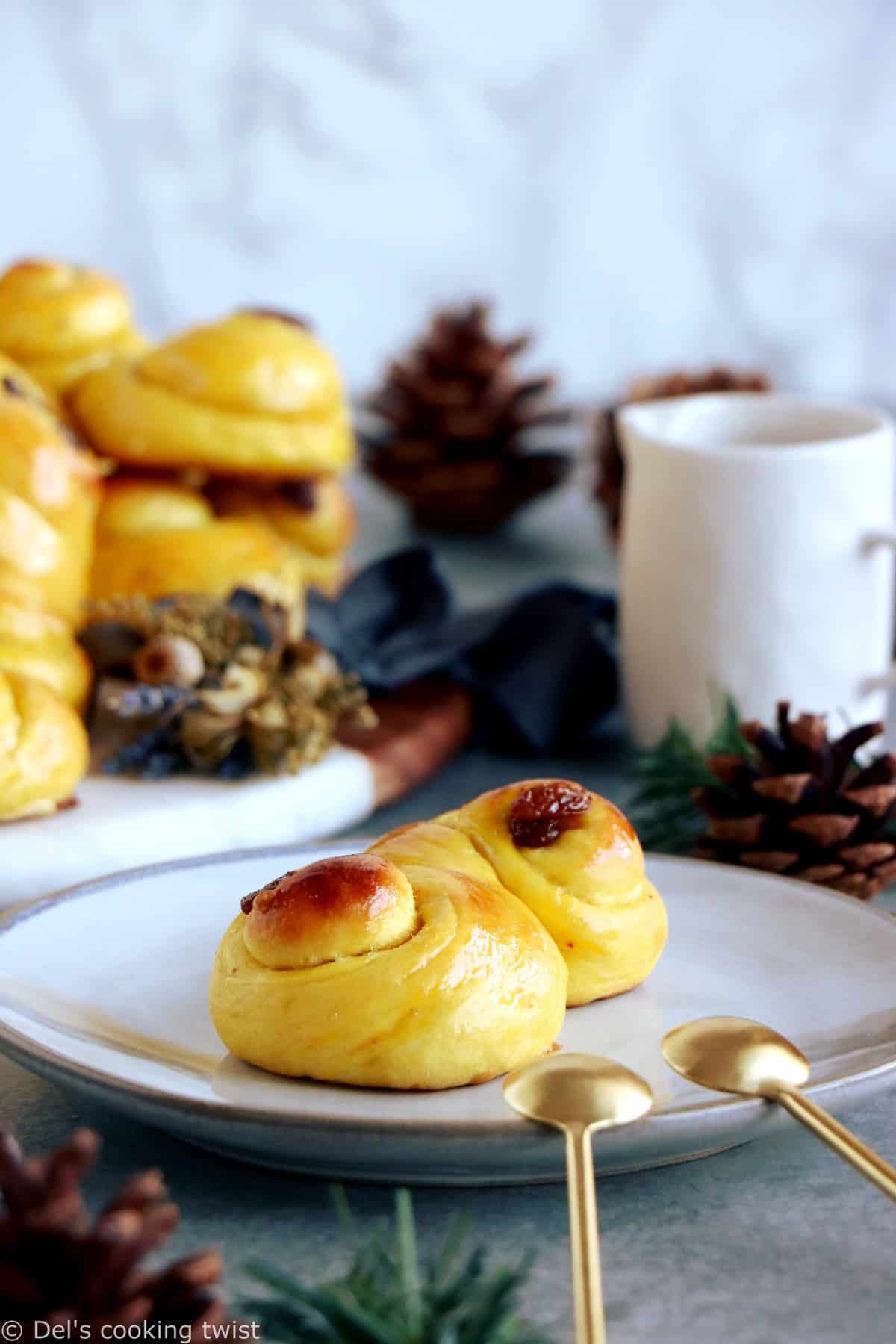
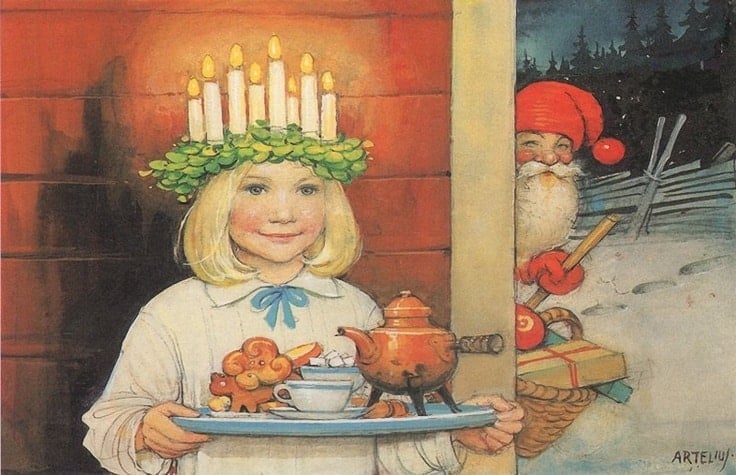
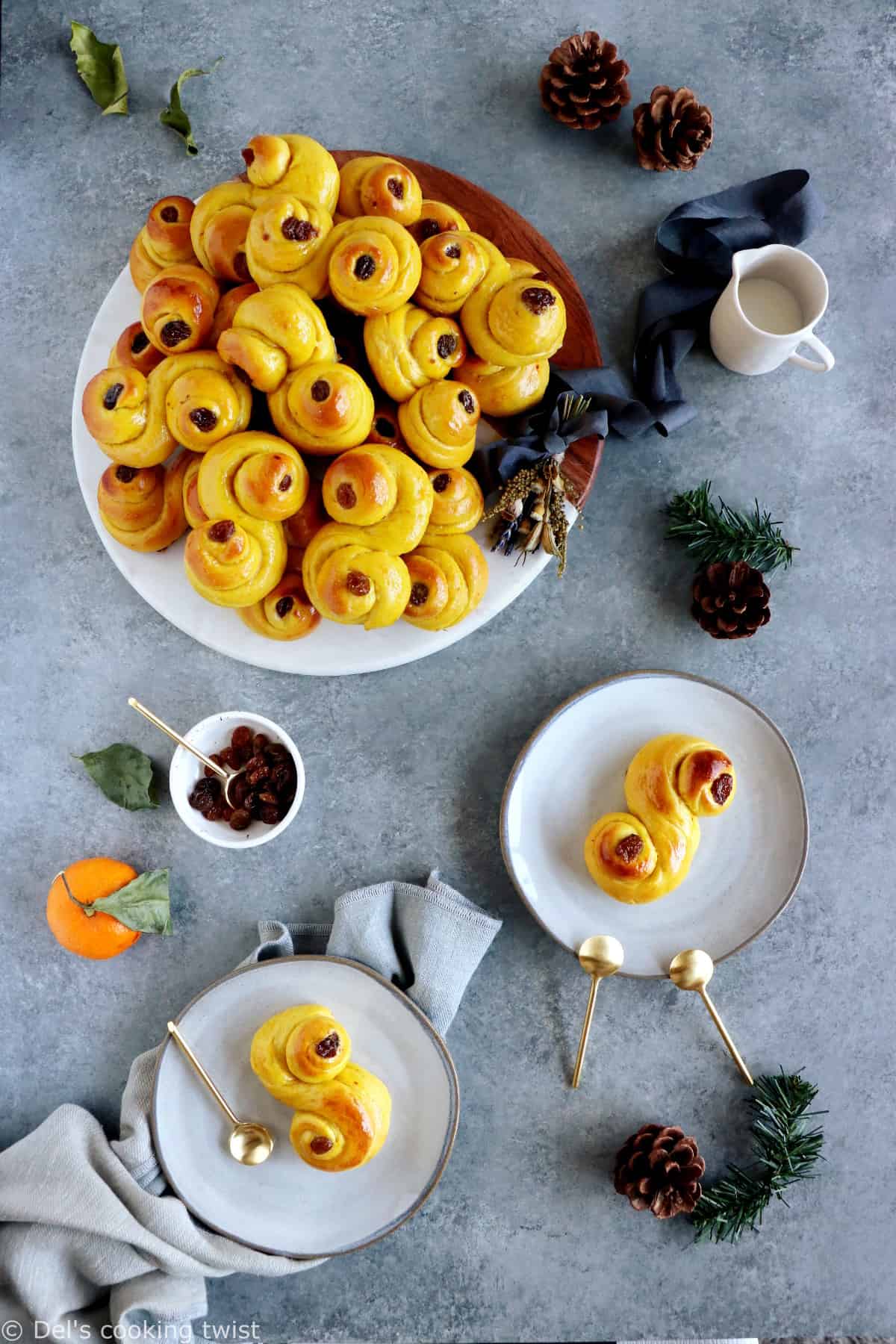
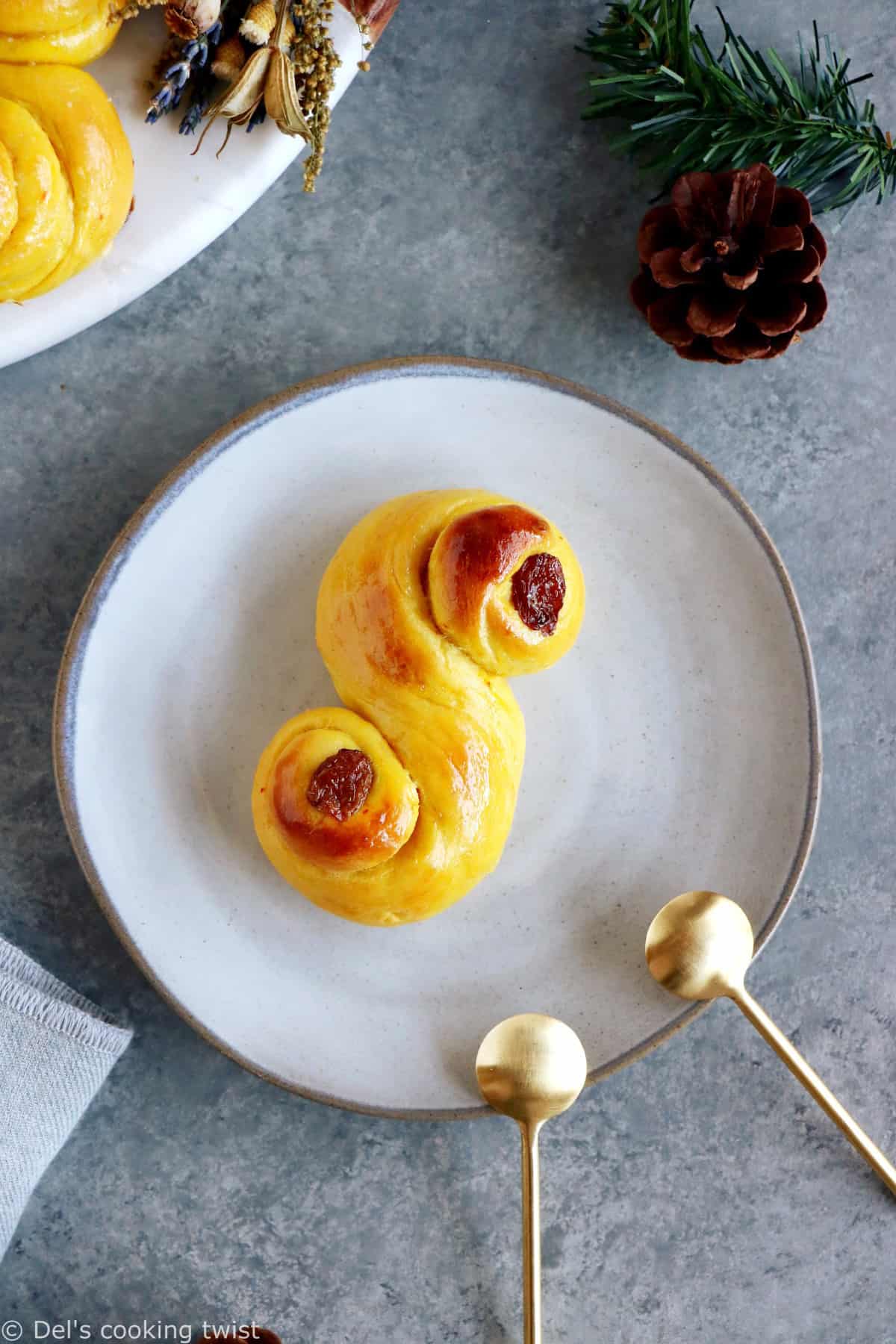
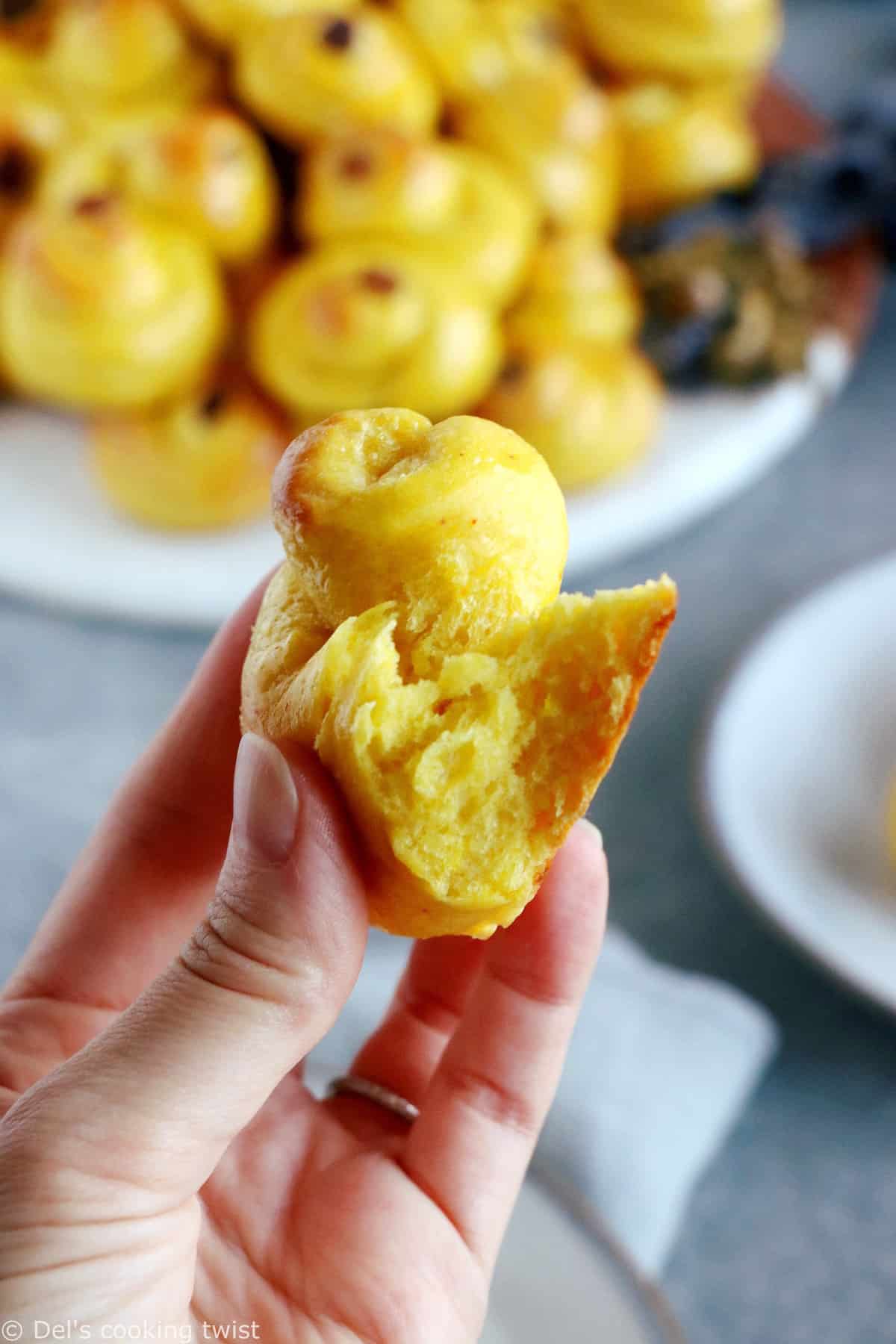
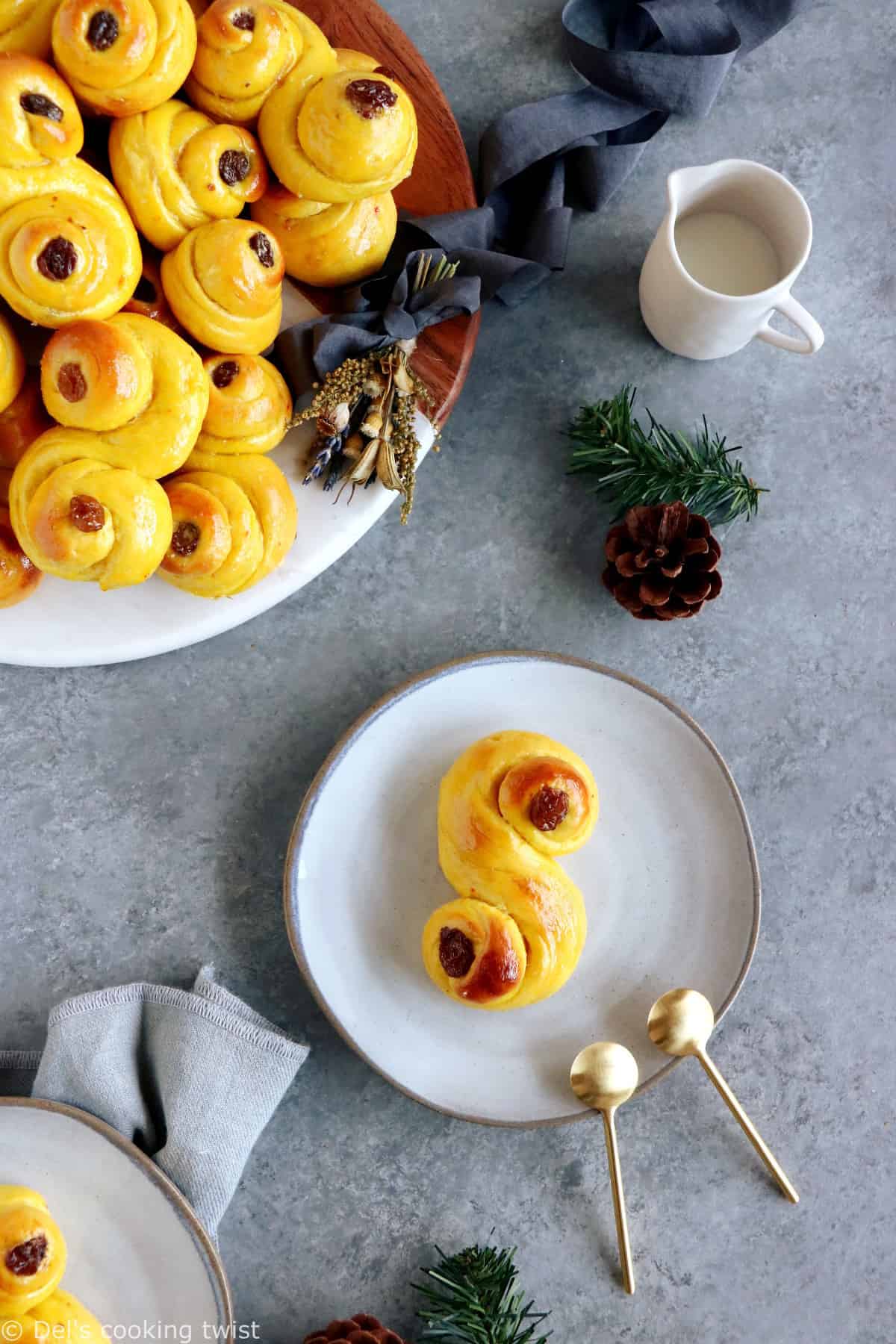
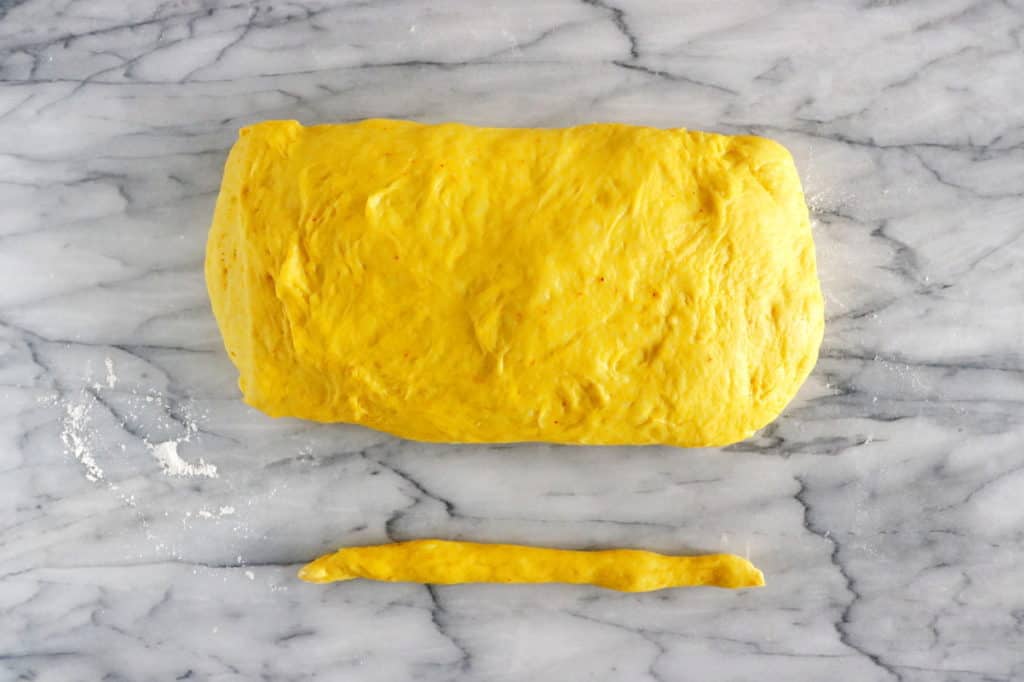
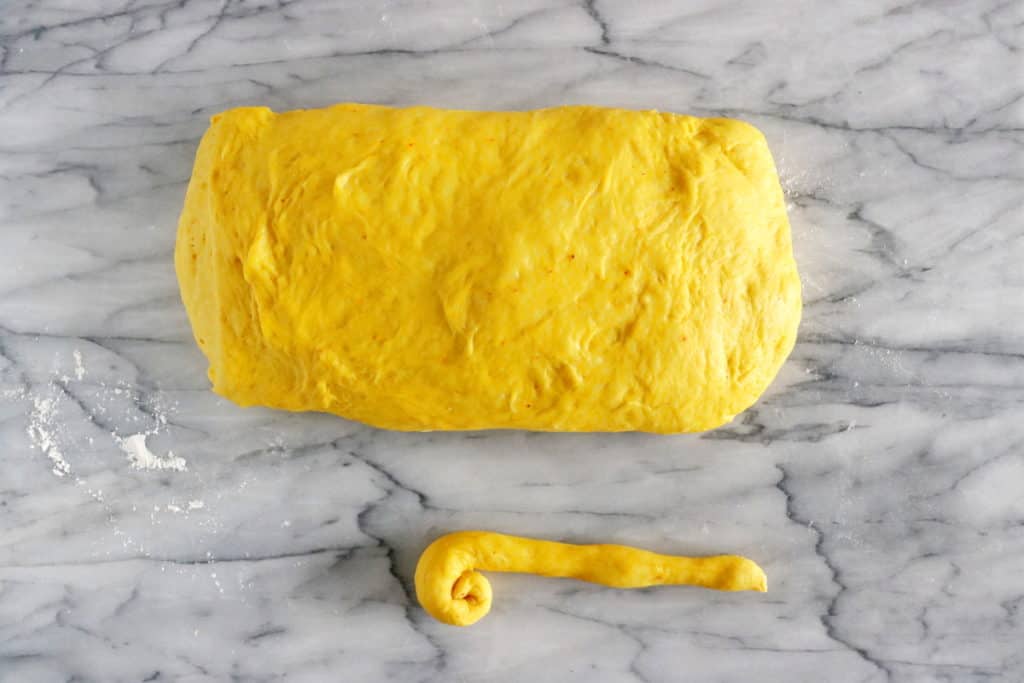

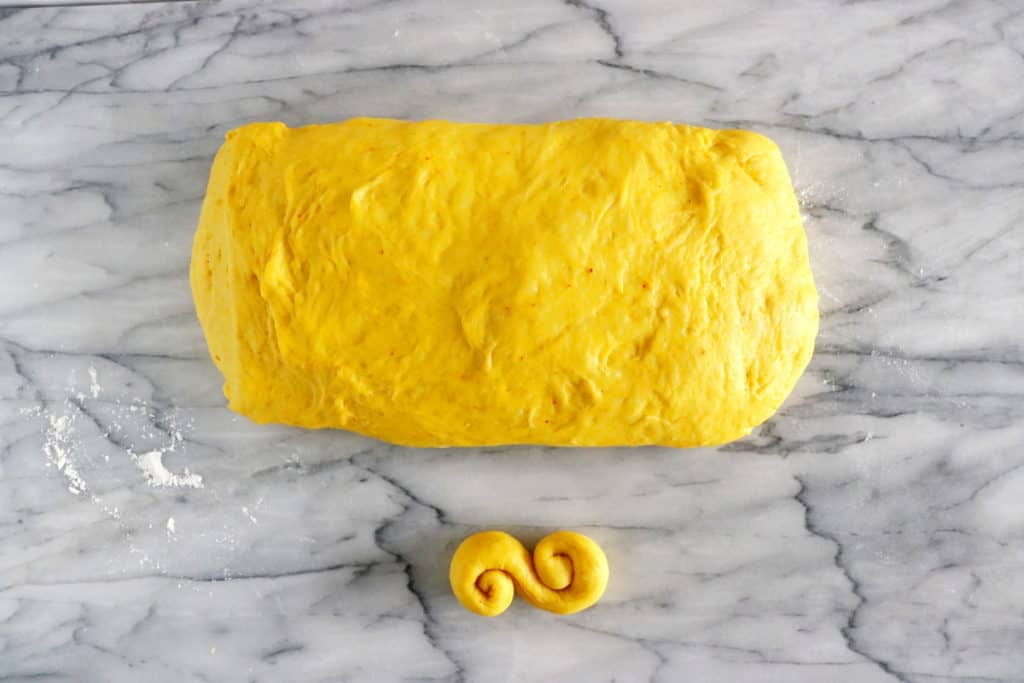
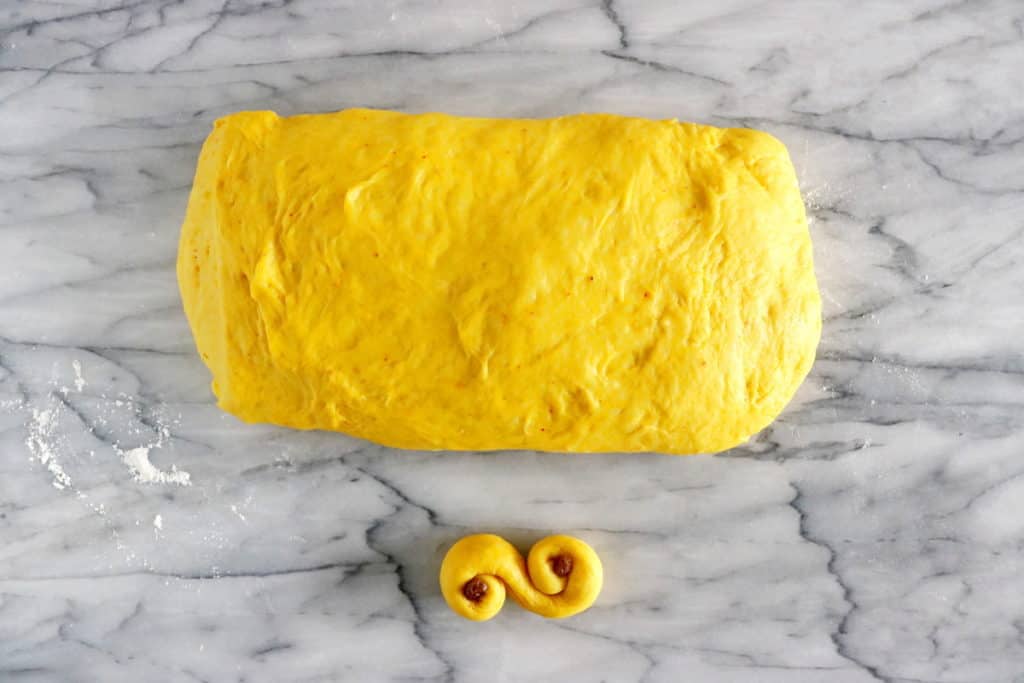
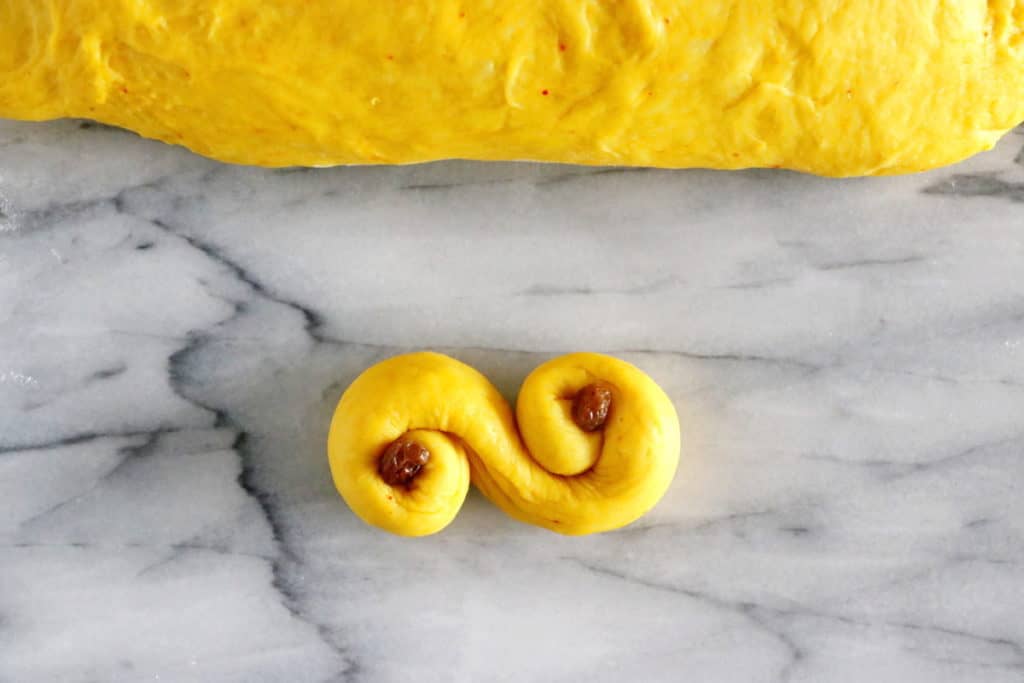
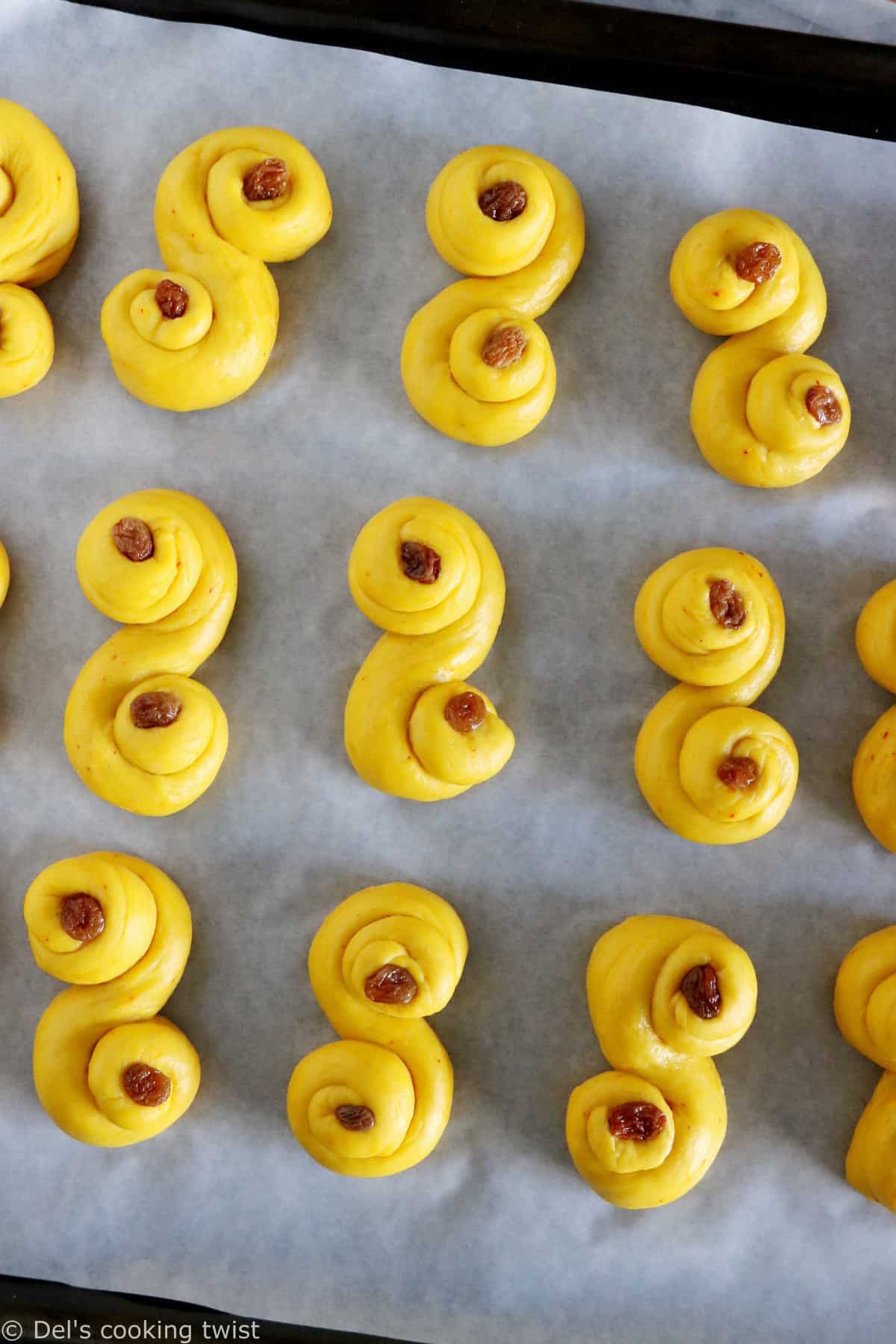
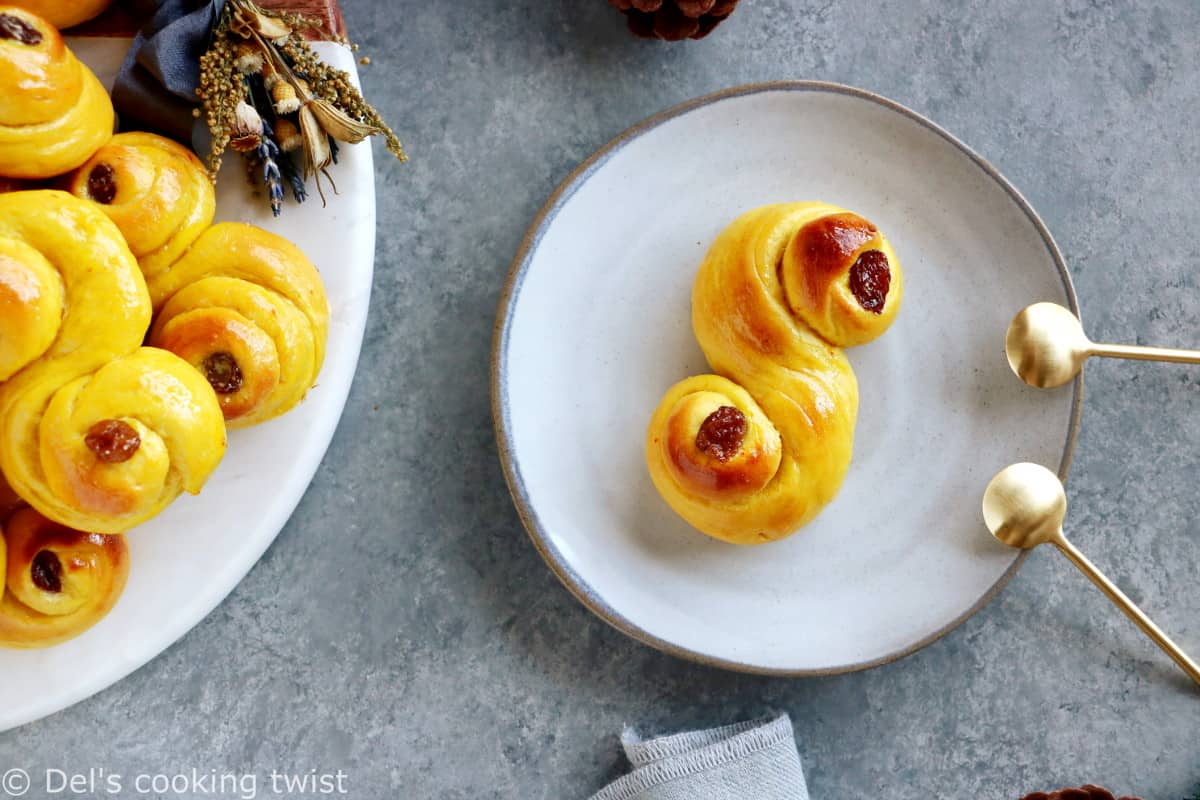
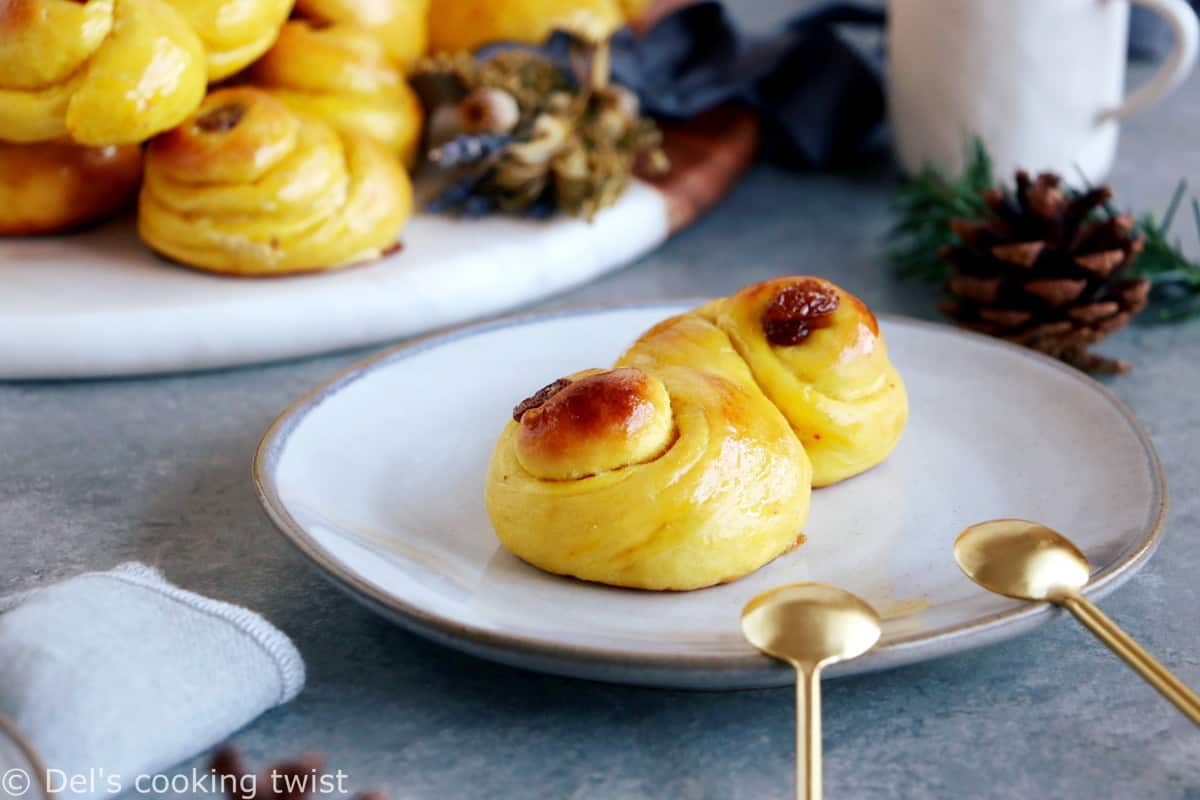

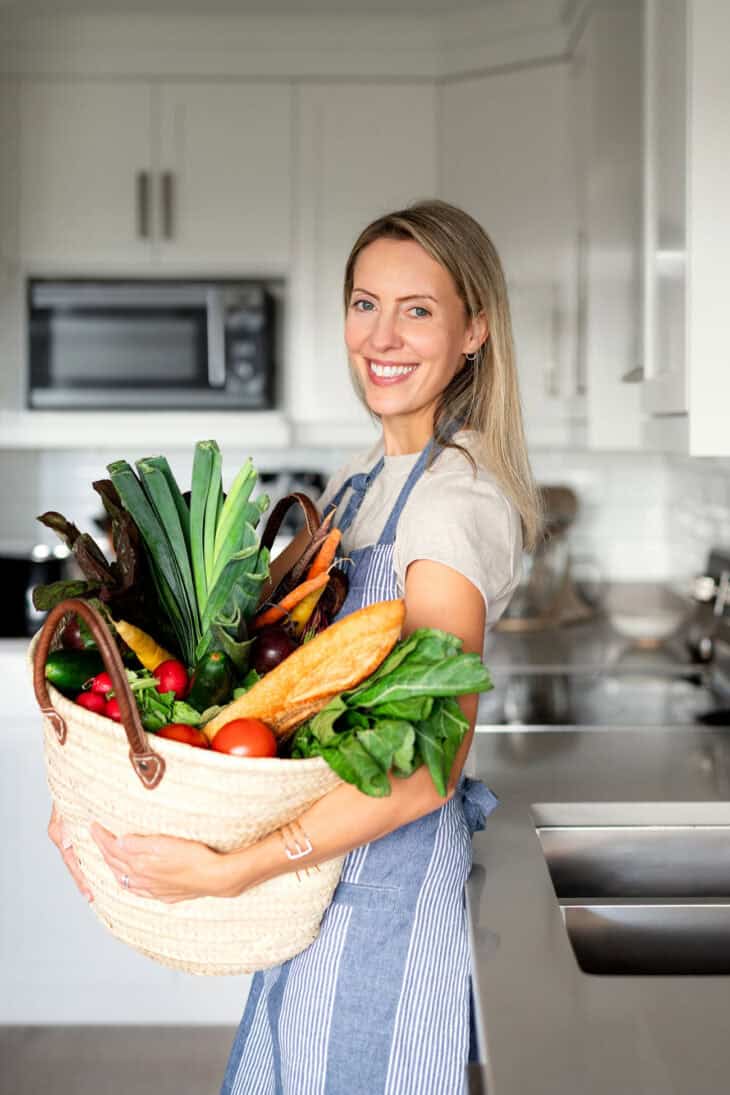

elodiesucree
Je les ai fait l’année dernière et c’était délicieux!!! Je les ai présenté sur mon blog : “
Delphine Fortin
Oh super! Je vais aller voir cela de ce pas 🙂
Candy
It’s remarkable for me to have a web site, which is valuable for my knowledge.
thanks admin
Winnie
These look and sound absolutely fantastic!!
Happy Holiday to you
Macy
These look great! Did you use saffron strands or ground saffron? And if you used strands, did you just remove the stands from the cognac / sugar mix or do you add the cognac and sugar mix, too? Thanks!
Delphine Fortin
Hi Macy! I’m glad to see your interest for this recipe! I actually used ground saffron and it works very well. Enjoy the saffron buns!
Camille / Caprices Gourmands
Ces brioches ont l’air géniales !
Fan de la Suède, elles se placent dans mes favoris, jusqu’à ce que j’ai un petit moment pour les faire 😀
Del
Si tu es fan de la Suède Camille, en effet elles sont incontournables ! Et la recette se fait en un tour de main. À toi de jouer !
Rula
Bonjour,
Merci pour cette recette et l’histoire…..J’ai essayé la recette… et c’était très bon.
Je n’ai jamais dégusté les brioches suédoises et je ne sais pas si j’ai réussi à avoir le même goût..)
*J’ai remplacé la levure du boulanger par la levure en poudre.
Merci….
Joyeux Noël et bonne année d’Amman (en Jordanie)
Rula
Del
Bonjour Rula. Je suis ravie d’apprendre que ces petites brioches vous ont plu et également de voir que ma petite recette connaît du succès jusqu’en Jordanie 🙂 Je vous souhaite une très bonne année 2014 !
Christiane
J’ai testé franchement je suis déçue je trouve qu’elles manquent de gout j’aurais mis plus de beurre et de sucre. Bref je vais revenir à la brioche traditionnelle que je trouve plus gouteuse.
Del
Bonjour Christiane. Je comprends votre déception si vous vous attendiez à retrouver le goût d’une brioche nature. Les petites brioches au safran sont plus subtiles en goût que les brioches traditionnelles et il est donc parfaitement normal qu’elles soient un peu moins sucrées et moins grasses également. Par ailleurs, il est important de choisir un safran de qualité et de bien le laisser macérer dans un peu de liqueur, car cela fait toute la différence au niveau du goût. Enfin, je recommande d’accompagner ces petites brioches d’un vin chaud ou bien d’une tasse de chocolat chaud !
Michèle
Hmmmm Ils ont pas l’air aussi bons et je trouve que 225C est trop chaud ce qui fait 425F ici et le dessus est presque brulé avant que le milieu soit cuit Bon j’imagine que si réussis elles doivent être délieuse j’attendrai de les déguster en Suède Merci tout de même Celles sur la photos sont certainement meilleures que les miennes
Del
Bonjour Michèle. Avez-vous bien enfourné à mi-hauteur ? Il se peut également que le four était un peu trop chaud lorsque vous y avez mis les petites brioches. En effet, entre le moment où l’on allume le four et le moment où l’on enfourne vraiment, cela peut prendre pas mal de temps (étant doné le temps que l’on passe à former les petites brioches). Je conseille donc surveiller la cuisson de très près. Je vais également ajuster le temps de cuisson dans ma recette, en préconisant une fourchette de 200-220C, pour éviter ce genre de désagrément. Et ne vous inquiétez pas, je suis sûre que votre prochaine fournée sera encore meilleure 🙂
Michèle
Oui la prochaine fois j'ajusterai la température et aussi je laisserai lever 2 fois comme je fais habituellement Elles étaient trop dense et j'ai une question … La photo est elle de vos brioches ou celles achetée a la boulangerie? C'est une belle photo qui donne le gout de les faire Je me demande quand j'y arriverai aussi bien
Del
Oui bien sûr Michèle que les brioches sur la photo sont ma propre réalisation. Il est pour moi inconcevable d’utiliser des photos qui ne seraient pas issues de mes propres recettes ! Donc rassurez-vous, il s’agit bien d’une recette réalisée par un amateur et en aucun cas par un professionnel. Vous pouvez parfaitement faire reposer les petites brioches une deuxième fois sous couvert d’un torchon pendant 30 minutes, cela devrait effectivement les faire lever un peu plus et donc rendre la texture peut-être un peu plus aériée. Cela dit, plus important encore est de bien pétrir au départ pendant 20 bonnes minutes. C’est un exercice un peu fastidieux et physique mais c’est cela qui aidera ensuite la pâte à lever. On recommande souvent d’utiliser un kitchen aid pour faire le travail pendant 12 minutes plutôt que de le faire à la main, car de la sorte le pétrissage est vraiment parfait. Pour ma part je l’ai fait à la main et cela a bien fonctionné !
Valérie / Framboises et bergamote
Dis moi, on n’est pas obligé de les faire juste pour la Ste Lucie ? Car sinon je devrai attendre un an ..
Moi qui adore la boulange, j’aime l’idée d’ utiliser le safran, cela me plait beaucoup et il faudrait vraiment que j’essaye.
bien belle journée
Del
Bonjour Valérie! Ici on a l’habitude d’en manger dès fin novembre et durant tout le mois de décembre, alors pas de panique surtout 🙂 Et oui, je te recommande l’idée du safran, une épice toute douce… Très bonne journée également !
Michèle
Je commence la recette Je me demande combien de levure en poudre utiliser Dans ma region impossible de trouver de la levure de Boulanger
Même si j’essaie de réduire ma consommation de féculent-gluten je suis trop gourmande en voyant vos belle brioches pour y résister Merci
Del
Bonjour Michèle! Ravie d’entendre que vous vous lancez dans ces petites brioches au safran! Il semblerait que l’on puisse remplacer de la levure de boulanger par de la levure chimique, dans la mesure où cette dernière est simplement l’extraction de l’eau que contient la levure fraîche. Par conséquent, pour la même quantité, la levure séchée est plus concentrée que la levure fraîche. Pour remplacer, il faut savoir que 8g de levure sèche correspond à 24g de levure fraîche. Mais attention toutefois, car la pâte à brioche ne lèvera pas au repos, mais seulement dans le four. Et il se peut cependant que le résultat soit légèrement différent au niveau de la consistance. N’hésitez pas à me faire part de votre retour, j’en serez ravie !
Michèle
Salut Del
Je suis au stage de pétrir une deuxième fois La pâte avec la levure sèche a doublée parfaitement Maintenant je divise en 20 et forme les brioches Je me demandais s'il fallait faire lever une deuxième fois ???
rouanne
Bonjour ,
Les petites brioches , sont bien tentantes , mais n’y à t-il pas une erreur dans les ingrédients ?
c’est noté 75 gr de levure fraiche , c’est sans doute 7,5 gr ! parce que sinon 75 gr me parait énorme .
En sachant qu’un paquet de levure pèse 42 gr et qu’il faut 1kg de farine pour 42 gr , je me pose la question , .
Pourriez vous éclairer ma lanterne s’il vous plait , merci
bonne journée
Del
Bonjour et merci pour votre commentaire judicieux ! En fait il s’agit bien de 75g de levure car j’utilise de la levure fraîche (ou levure de boulanger, disponible en rayon frais), qui est beaucoup plus lourde que la levure en poudre. Dans certaines recettes on préconise seulement 50g, donc c’est à vous de voir. Dans tous les cas on utilise souvent de la levure de boulanger plutôt que de la levure en poudre dans la pâte à brioche. J’espère avoir répondu à votre question et je vous souhaite de très belles fêtes de fin d’année 🙂
mimi
Essayer c’est l’adopter, Une recette très facile à réaliser et surtout très bonne. J’ai adoré ces brioches<3<3<3 Je les refais la semaine prochaine Insch'Allah. Merci " Del's cooking twist" merci aussi pour l'histoire de ces bonnes brioches……..
Del
Oh! Je suis vraiment ravie que ces petites brioches t’aient plu ! Moi aussi il faut que je m’y mette pour une deuxième fournée à l’approche de noël 🙂 Bises !
hibiscus
On peut aussi faire des brioches au safran fourrées à la pâte d’amande. 🙂 J’espère pouvoir mettre la recette bientôt sur mon blog, en attendant voici un lien avec une photo contenant les “lussekatter” et les “lussebullar” (fourrés) : .
Del
Hmmm… je m’en vais y faire un tour, en souvenir du glögg d’il y a quelques semaines 🙂 Et hâte de voir ta prochaine recette avec de la pâte d’amande !!
hibiscus
La voilà : http://hibiscusblog.net/2013/12/16/brioches-au-safran-x-2/ 🙂
Juliette
Merci beaucoup pour ce nouveau blog que je découvre et en plus, je tombe directement sur la recette des lussekatters ! Au passage, je remarque que tu mets un gramme de safran, je prends note car rien de vaut la version originale de la recette !
Je sens que je vais aller flâner sur ton blog et découvrir un peu plus le patrimoine culinaire suédois (et autre car je suppose que tu ne cuisines pas uniquement local !). je fais évidemment suivre à ma fille Marjorie qui n’a pas changé depuis l’année dernière en ce qui concerne son amour pour la Suède !
Bien belle découverte à l’approche des fêtes… un peu comme un cadeau de Noël avant l’heure !
A bientôt Del (…phine peut-être)
Del
Bienvenue dans mon univers culinaire également ! En espérant qu’il plaira tout autant à Marjorie. Je vous souhaite à toutes les deux de très belles fêtes de noël ! Et bien joué pour mon prénom 😉
Aux Fourneaux
Elles sont superbes tes brioches !!! elles me font bien envies 🙂
Bizz
Del
Merci beaucoup pour ce joli compliment 🙂
sotis
j’voudrais en attraper une mais j’peux pas snif!!! bisous
Del
Fais un petit tour en Suède en fin de semaine, tu auras droit d’en attrapper un ou deux et de voir la procession de Sainte Lucie par la même occasion 🙂 Bises
Rose
Well, I don’t which one of the stories is true but she hadn’t got a pretty life this Lucy! I didn’t know the origins, thanks for your writting!
And your Lussekatter looks really perfect, grattis!
Del
Tack Rose 😉 The same for me, I didn’t know the origin of Lucy until I wrote this article. Ready for Friday now, with some Lussekatter of course!
Rosenoisettes
Merci pour cette histoire liée aux délicieuses brioches présentées.
Je n’ai que rarement eu l’occasion de goûter au safran, mais je suis sûre qu’il est bien plus sublimé côté sucré que salé alors cette brioche me tente bien.
Del
Oui c’est un joli conte je trouve, et l’ambiance suédoise pour recréer l’atmosphère de noël autour de Lucie nous plonge dans un univers féérique… Et ces petites brioches moelleuses seront l’occasion pour toi d’essayer le safran, une épice toute douce ! 🙂